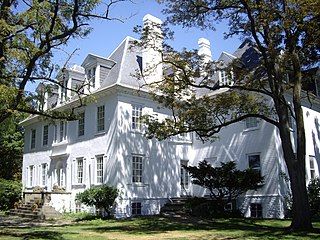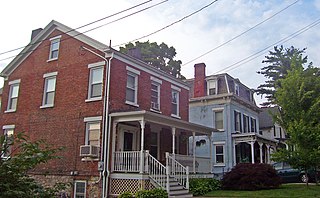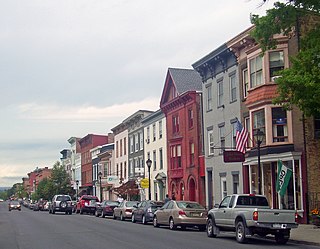
Clermont is a town in Columbia County, New York, United States. The population was 1,965 at the 2010 census. The name of the town is French for "Clear Mountain", in reference to the mountain views in the town.

The Clermont State Historic Site, also known as the Clermont estate, the Clermont Manor or just Clermont, is a New York State Historic Site in southwestern Columbia County, New York, United States. It protects the former estate of the Livingston family, seven generations of whom lived on the site over more than two centuries.

The Daniel Waring House, also known as Indian Hill, is located on River Road just outside the village of Montgomery, New York, United States. It sits on a large parcel of land overlooking the Wallkill River at the junction of River Road and NY 17K, just opposite the western approach to Ward's Bridge.

Montgomery Place, now Bard College: The Montgomery Place Campus, near Barrytown, New York, United States, is an early 19th-century estate that has been designated a National Historic Landmark. It is also a contributing property to the Hudson River Historic District, itself a National Historic Landmark. It is a Federal-style house, with expansion designed by architect Alexander Jackson Davis. It reflects the tastes of a younger, post-Revolutionary generation of wealthy landowners in the Livingston family who were beginning to be influenced by French trends in home design, moving beyond the strictly English models exemplified by Clermont Manor a short distance up the Hudson River. It is the only Hudson Valley estate house from this era that survives intact, and Davis's only surviving neoclassical country house.

The Hudson River Historic District, also known as Hudson River Heritage Historic District, is the largest Federally designated district on the mainland of the contiguous United States. It covers an area of 22,205 acres extending inland roughly a mile (1.6 km) from the east bank of the Hudson River between Staatsburg and Germantown in Dutchess and Columbia counties in the U.S. state of New York. This area includes the riverfront sections of the towns of Clermont, Red Hook, Rhinebeck and part of Hyde Park. This strip includes in their entirety the hamlets of Annandale, Barrytown, Rhinecliff and the village of Tivoli. Bard College and two protected areas, Margaret Lewis Norrie State Park and Tivoli Bays Unique Area, are also within the district.

The Hoornbeek Store Complex is a Registered Historic Place in the hamlet of Napanoch, New York, United States. It consists of several buildings located on a one-acre parcel on Main Street between Clinton and Church streets. They reflect Napanoch's transition from its original settlement into the Delaware and Hudson Canal era and the move from Federal style to Greek Revival as the dominant style in American architecture.

The Dodge-Greenleaf House is on NY 211 in Otisville, New York, United States. It was built circa 1855 in the Gothic Revival style. The architect is unknown but it exemplifies contemporary trends in home design popularized by the writings and pattern books of Andrew Jackson Downing of nearby Newburgh, as articulated in the Picturesque mode.

The Stone Street Historic District is a one-block section of the west side of that street in the hamlet of New Hamburg, New York, United States. It was recognized as a historic district and added to the National Register of Historic Places in 1987 as the largest group of intact houses in the hamlet.

The Second Baptist Church in Poughkeepsie, New York, United States, is located at the corner of Vassar and Mill streets. It is a wooden building from the late 1830s in the Greek Revival architectural style, the only remaining church in the city in that style.

The building at 73 Mansion Street in Poughkeepsie, New York, United States, was first built around 1890 as a single-family residence. It is next to the city's post office and across from the offices of the Poughkeepsie Journal, at the corner with Balding Avenue.

The Main Street–Albertson Street–Park Place Historic District is located in the residential neighborhood just west of US 9 near central Hyde Park, New York, United States. It is a predominantly residential area of 6.8 acres (2.8 ha) along the named streets, also including Hyde Park's library and a few former church buildings since converted into houses.

The Benner House is located on Mill Street in the village of Rhinebeck, New York, United States, just off U.S. Route 9. It was built by a German immigrant, Johannes Benner, in the 1730s. It is the oldest house in the Village of Rhinebeck.

Clarkson Chapel is located on New York State Route 9G in Clermont, New York, United States, just across from the Coons House. It is a mid-19th century wooden building in the Carpenter Gothic style.

The Hudson Historic District includes most of downtown Hudson, New York, United States, once called "one of the richest dictionaries of architectural history in New York State". It is a 139-acre (56 ha) area stretching from the city's waterfront on the east bank of the Hudson River to almost its eastern boundary, with a core area of 45 blocks. It has 756 contributing properties, most of which date from the city's founding in 1785 to the mid-1930s. In 1985 it was listed on the National Register of Historic Places.

There are 75 properties listed on the National Register of Historic Places in Albany, New York, United States. Six are additionally designated as National Historic Landmarks (NHLs), the most of any city in the state after New York City. Another 14 are historic districts, for which 20 of the listings are also contributing properties. Two properties, both buildings, that had been listed in the past but have since been demolished have been delisted; one building that is also no longer extant remains listed.

The Boice House is located on Fair Street in Kingston, New York, United States. It was first built around 1850 in the Greek Revival architectural style.

The Cornelius Carman House is located along River Road South in Chelsea, New York, United States. It is a wooden house built in the 1830s, overlooking the Hudson River, for Carman, operator of a local shipyard and inventor of a moveable centerboard.
Barringer Farmhouse is a historic structure located in Rhinebeck, New York, just west of US 9. Built c. 1830, the building is in a sparsely populated neighborhood and is accessed via an unpaved road north of Fox Hollow Road. The lot covers 15.2 acres (6.2 ha) of land, characterized by hills and open fields with lightly wooded areas. The building itself sits at the crest of a knoll overlooking two large ponds. The ponds were created by the Fallsburg Creek, which forms the eastern boundary of the property.

Nut Grove, also known as the William Walsh House, is a historic house located on McCarty Avenue in Albany, New York, United States. It is a brick building originally designed in the Greek Revival architectural style by architect Alexander Jackson Davis in the mid-19th century. In 1974 it was listed on the National Register of Historic Places.

The Broadway–Livingston Avenue Historic District is located at the junction of those two streets in Albany, New York, United States. It includes seven buildings remaining from an original 20, all contributing properties, and a Warren truss railroad bridge. In 1988 the area was recognized as a historic district and listed on the National Register of Historic Places.




















